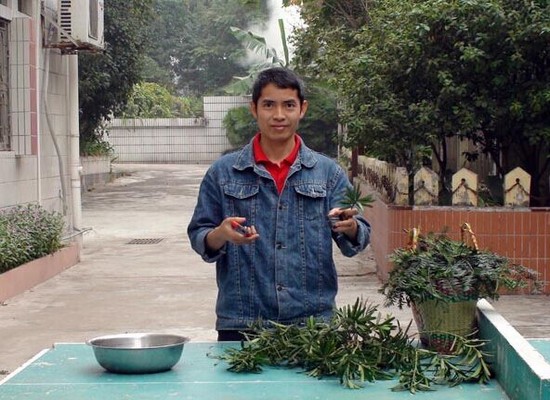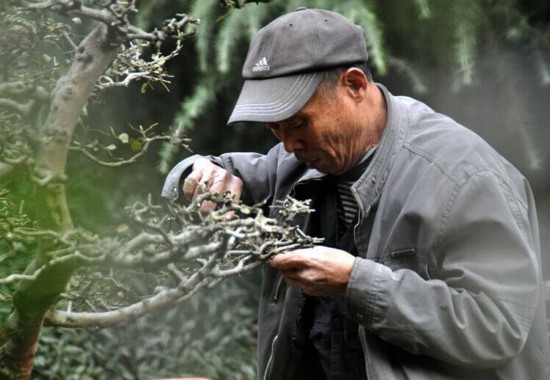Fertilization skills of tree stump bonsai
The soil in the pot of tree stump bonsai is limited, so the nutrients are also limited, so we should pay attention to the supplement of fertilizer. Because of its artistic characteristics, tree stump bonsai should not be fertilized too much or too frequently. It is necessary to master the content and types of fertilization and grasp the fertilization season. The three elements of plant growth nutrients are nitrogen, phosphorus and potassium fertilizer, nitrogen fertilizer can promote the growth of branches and leaves, phosphorus fertilizer can promote the formation of flowers and fruits, and potassium fertilizer can promote the growth of stem and root. therefore, the selection of fertilizer should be determined according to the type of tree stump and its growth trend.

If you need to make the stump flourish, you can apply more nitrogen fertilizer; if you need more flowers and fruits, you can increase the content of phosphate fertilizer; when you need strong roots, you can apply more potash fertilizer. Fertilization methods are generally divided into late fertilization and quick fertilization. Delayed fertilization generally mixes organic fertilizer into the soil according to a certain proportion after crushing and maturing, and when changing soil, it is mixed into the basin to slowly provide nutrients; quick-acting fertilization is to dilute organic fertilizer or chemical fertilizer. Fertilization is carried out according to the seasonal growth needs of tree stumps, but it should not be too thick, newly planted tree stumps should not be fertilized in rainy days, fertilizer efficiency is lost, and the effect is not good.
If there is too much fertilizer, the branches and leaves will grow; the lack of fertilizer, the branches are thin and weak, the leaves turn yellow, and they are vulnerable to diseases and insect pests. Therefore, we should apply fertilizer scientifically according to time, quantity, fertilizer and tree species.
Due to time:
Newly planted, newly potted or newly changed soil, due to root damage, temporarily do not apply fertilizer, until the beginning of spring or early summer, pot trees in the peak growing season to apply more fertilizer. The slow growth of potted trees in autumn should be fertilized less, and fertilizing should be stopped when potted trees have entered the dormant period in winter. It is not suitable to apply fertilizer around noon in rainy days or high temperature in summer, because fertilization in rainy days is easy to lose and damage the root system. Fertilization is the best in cloudy days or in the evening. When the basin soil is slightly dry, first remove weeds and loosen the soil, which is conducive to fertilizer infiltration into the soil, accelerate fertilizer decomposition and absorption, and avoid fertilizer damage at the same time.
Factor:
Tree stump bonsai fertilizer should grasp the principle of a small number of times, each time the amount of fertilizer should be less, should be sparse. Generally speaking, the Beginning of Spring applied rarefied fertilizer and water (7% water and 3% fertilizer) to the Beginning of Autumn every 10 days, but did not apply fertilizer after the Beginning of Winter.
Because of fatness:
Nitrogen fertilizer promotes the plant to grow luxuriantly and has more buds. The commonly used nitrogen fertilizers are bean cake, ammonium sulfate and fertilizer and water. Phosphate fertilizer promotes colorful flowers and fruits, such as calcium superphosphate bone powder and so on. Potash fertilizer promotes the development of root system and firm plant, such as potassium fluidic acid, plant ash and so on. It is necessary to apply fertilizer separately according to the growth of the plant, and at the same time, it should be controlled flexibly according to the characteristics and growth of the tree species.
Time: 2019-06-12 Click:
- Prev

The method of raising seedlings of bonsai by cutting propagation
Cuttage propagation has the advantages of simple and rapid operation, high efficiency and low cost. Normal cutting seedlings have good root extension, high survival rate and fast growth, so they are deeply welcomed by farmers. 1. Mechanical treatment 1. Peeling the fruit trees with more developed branch cork tissue, and varieties that are more difficult to root, peel off the cork layer of the epidermis before planting.
- Next

Pruning technique of bonsai with tree stump
Tree stump bonsai is a kind of living work of art that plants old woody plants are planted in a basin, after years of pruning, binding, fertilization and other artistic processing, fine management, so that the trunk is vigorous and powerful, branches and leaves luxuriant. It will not be shaped by the first artificial shape, but will continue to grow and change according to the laws of nature, so
Related
- Fuxing push coffee new agricultural production and marketing class: lack of small-scale processing plants
- Jujube rice field leisure farm deep ploughing Yilan for five years to create a space for organic food and play
- Nongyu Farm-A trial of organic papaya for brave women with advanced technology
- Four points for attention in the prevention and control of diseases and insect pests of edible fungi
- How to add nutrient solution to Edible Fungi
- Is there any good way to control edible fungus mites?
- Open Inoculation Technology of Edible Fungi
- Is there any clever way to use fertilizer for edible fungus in winter?
- What agents are used to kill the pathogens of edible fungi in the mushroom shed?
- Rapid drying of Edible Fungi

